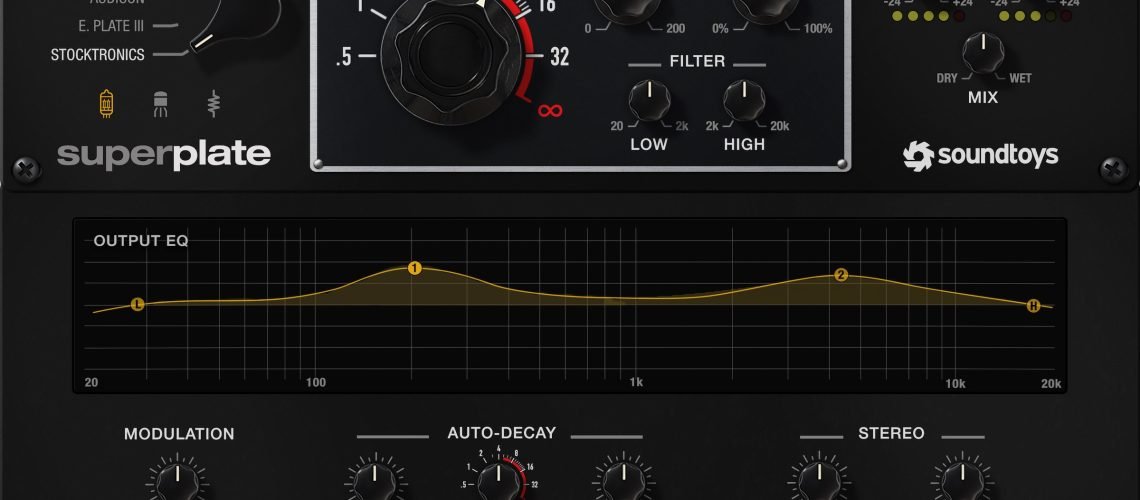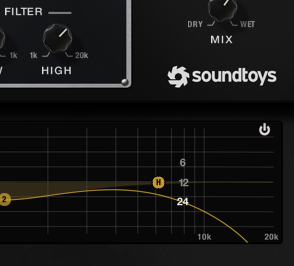In the midst of lots of splashy effects, Soundtoys’ latest is an exercise in subtlety and precision. These plates are as lush as you’d expect, but they stand apart in giving you detailed control over their results.
Soundtoys to me is a model of indispensable, desert island-necessity plug-ins. Yes, you get plenty of effects choices and a ton of presets – both in their individual plug-ins and in the combos in the Effects Rack. But you also will also find a particular device and even particular controls that you can easily rely on. It’s the opposite of plug-in overload – even if I’m personally guilty of creating some RAS (Reverb Acquisition Syndrome) here.
So while I’m sure plenty of people would still like to see a new build of the full Soundtoys set – Soundtoys 6, anyone? – SuperPlate deserves to stand on its own. (Soundtoys has added updated OS, Apple Silicon, and VST3 support for the full library.)
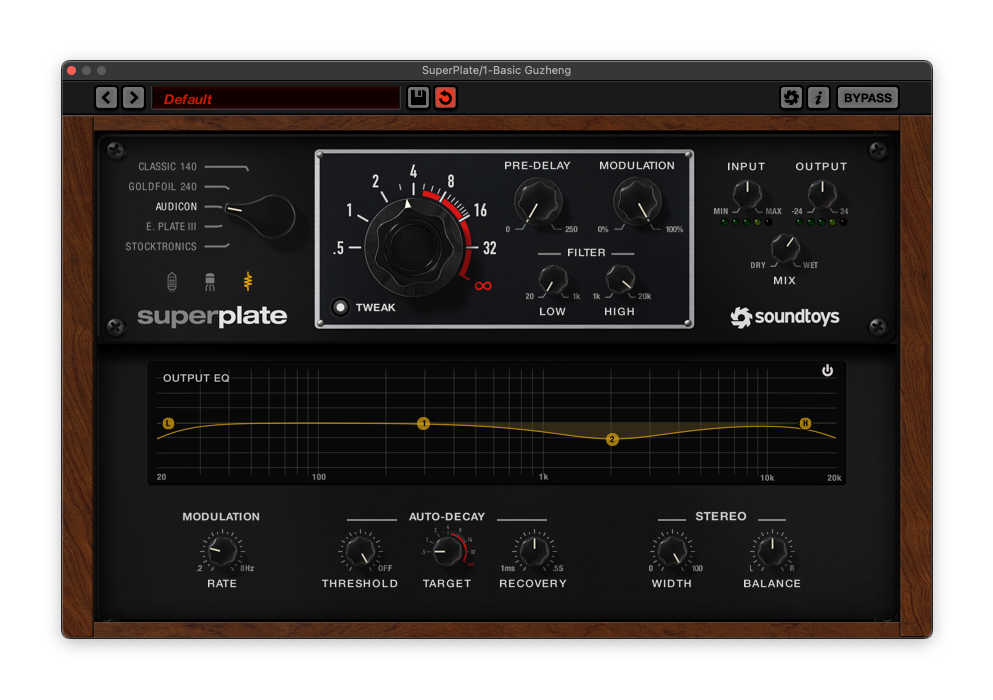
Spinning plates
The original plate reverbs are extraordinary beasts, built on acoustic resonance and electromagnetically activated metal – an EMT 140 weighs nearly 300 kg. For all the software plate reverbs out there, the quality can be variable, especially when recreating the historic devices. (Digital models are easier to do, and open up their own creative possibilities, as I observed in my Piastrone review.)
There’s still plenty of reason to rely on expert human modeling to get these right. And for all the repetition in plug-ins, the SuperPlate options are unique – even when compared to what you’ll typically find in convolution reverbs. (Convolution uses a different approach, working with digital samples of the originals.)
Soundtoys says they spent years on researching and developing this effect. They focused on five models:
EMT 140 (labeled “Classic 140”): The best-known plate and most modeled, this was already in the Little Plate. You do get some new features with it in this version, though.
Goldfoil 240 (EMT 240): Okay, I actually didn’t know that the EMT 240 had an 80 micron plate made out of gold foil – Soundtoys notes that that’s the thickness of a piece of aluminum foil. But this is a darker, shorter counterpart to the 140, and often more useful when the 140 is overwhelming.
Audicon: aka “The Plate II,” associated with Nashville, a punchier, lighter sound (I think you can even hear that in my Bad Demo).
E. Plate III: An ECOPLATE III by Jim Cunningham / Studio Technologies. This is the one you hear from the likes of Michael Jackson and Quincy Jones. It’s brighter and works well on percussion.
Stocktronics RX4000: This is also rare, though you’ll sometimes see it labeled “Swedish plate” in IRs for convolution reverb. It’s a very bright-sounding effect made from stainless steel by Lars “Stockis” Liljeryd.
They’ve then added variations to the preamp models, the first two based on the EMT:
- Tube (EMT V54), which both colors the reverb and, as you drive it harder, adds some pleasant distortion.
- Solid State (EMT 162) which also includes built-in compression.
- Clean (no added coloration).
So speaking of subtlety, sometimes adjusting this won’t do much at all. The trick is to play with material with more transients, and see what happens driving up against the compressor. It’s also a case of what digital software models can do that physical hardware can’t; the two EMT circuits were originally only inside the EMT, which means that until they became software, they’d never been heard with these other plates.
As I said, this is a Bad Demo – I wanted to focus on understanding the plate and playing, which is sort of a different workflow to creating cool demos. But here’s me with an internal Ableton Live instrument (AAS-developed Tension and an MPE controller). This sound on its own is almost completely dry; those physical models do bring out what the resonation characteristics of the reverb can add:
Precise control
Exaggerating only slightly, here’s a typical workflow for adding plate reverbs to a session:
Add a plate reverb. Marvel at its lush sound. Realize it has completely muddied up your mix and buried all the transients. Turn it off again.
That’s too bad, because there is something special about the harmonic characteristics of a really good plate model. What SuperPlate has done, though, is to provide an unusual array of controls – including the ability to create an infinite decay (essentially, a continuous “freeze”) when that is actually what you want.
Some of these controls are obvious – the decay time, which is clearly marked from short-ish times (down to half a second) up to too long and finally infinite. And there’s a pre-delay control (0 – 250 ms), mix, input and output, and the basic filter controls.
If you click TWEAK, though, you get some additional details:
Modulation / Modulation Rate. This adds pitch variation in the decay, which can be a way to reduce accumulated resonance and smooth out the tail. You can use the two creatively, too, though, for more exaggerated effects, especially with longer decays.
Parametric EQ (2-band) / visual EQ. The Tweak option adds two bands of draggable parametric EQ, plus visual controls for the low and highpass filters.
Hidden feature: You can adjust bandwidth (Q) – ctrl/alt + scroll on top of band.
Plus –
Filter curves. Click on the lowpass or highpass bands on the EQ under tweak, and you’ll see options for the6, 12, or 24 dB slopes.
Auto-Decay. This one is new and – actually huge. Looks like a duck, quacks like a duck. It’s not ducking. It dynamically reduces the decay time based on a threshold. Auto-Decay in practice is a lot more musical and effective than traditional ducking as found on some other reverbs.
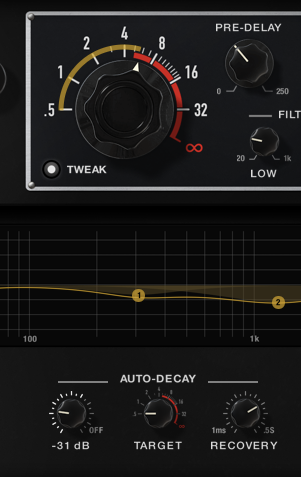
The idea is to use the Auto-Decay and Threshold values in concert, so usefully they’ve added extra visualizations. You get an indicator of the signal level on the threshold control itself, and a gold ring on the main decay knob shows how the decay time is attenuated.
Looks like a duck, quacks like a duck. But Auto-Decay in practice is a lot more musical and effective than traditional ducking as found on other reverbs.
Stereo width, pan. Little Plate modeled the original EMT with a summed-to-mono input. SuperPlate is stereo in, stereo out. That also gives you stereo width with mono inputs. There’s a continuous width control, plus panning via the Balance control – meaning you can set width to zero (or wherever) and pan where you want.
All of this means it is useful to keep Little Plate around if you just want a ‘classic’ EMT and those settings. That’s normally the case with the Soundtoys suite; the “Little” versions do still sometimes come in handy.
Hidden feature: Parameter lock – ctrl+opt / ctrl+alt any parameter to lock it when swapping between presets.
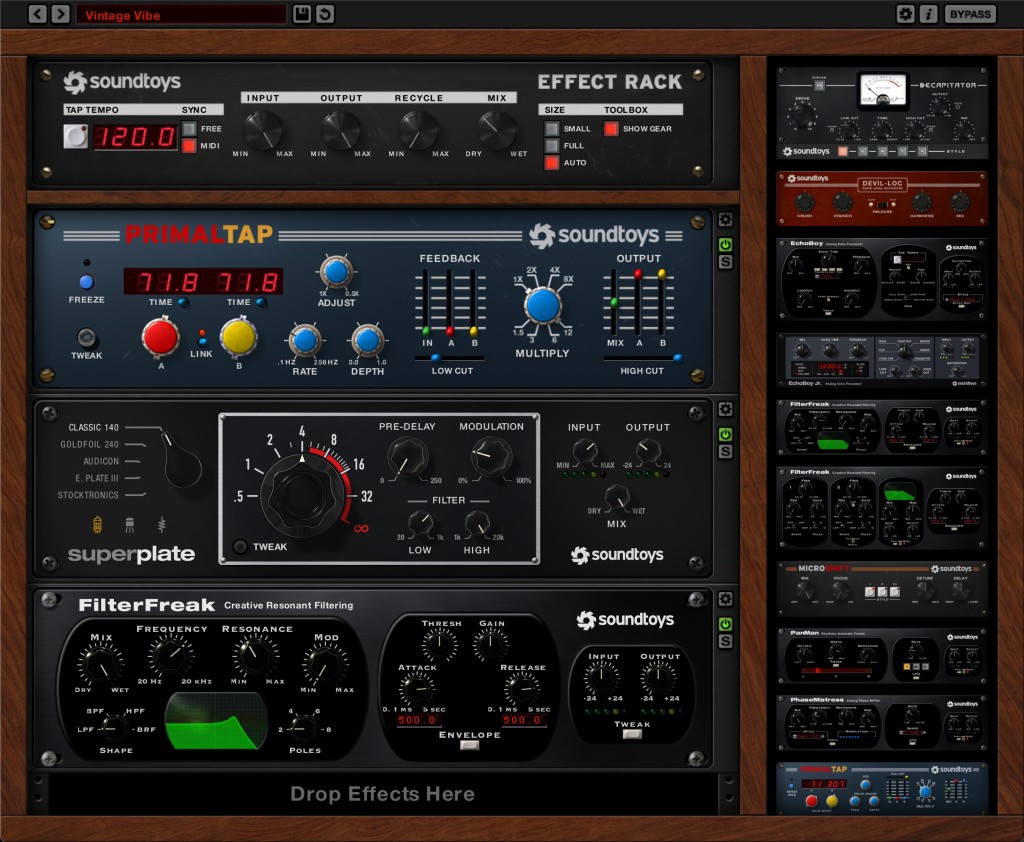
Conclusions
Amidst so many reverbs, SuperPlate is really deceptively powerful. For the moment, I can’t think of a more direct tool for lush, long plate reverbs – or for then tuning the results with Auto-Decay. It’s another instant Soundtoys classic. And it nicely complements the array of delicious digital reverbs (vintage and new) we now have at our disposal.
Through June 14, it’s also not terribly expensive (after-intro pricing in parentheses):
New: $79. (then $149)
If you have SoundToys 5.3 Bundle, it’s $29 to upgrade ($59).
Bought Little Plate? It’s $29. ($59)
Effect Rack: $79. ($149) And that includes both a version that runs in Effect Rack and on its own.
This is especially nice – if you got a free copy of Little Plate, it’s $39. ($79)
I’m still curious, as I’m sure many of you are, where Effect Rack and the Soundtoys Bundle will go next. But in the meanwhile, this is an indispensable addition.
